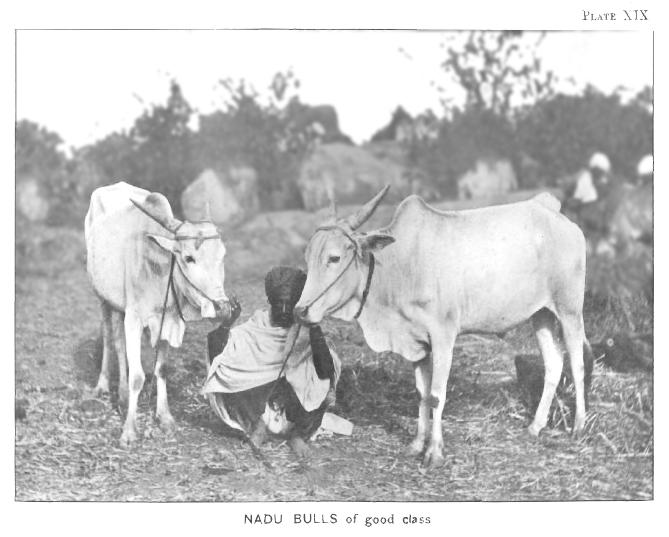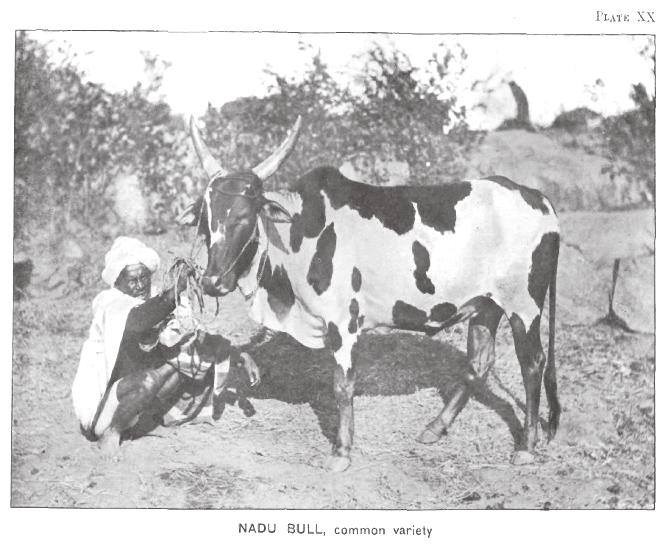a bit of Miniature Zebu history from
Breeds of Indian Cattle
The CATTLE of MYSORE
Rare Book Society of India
1895

PLATE 19
"Nadudana" or village cattle.
Mysore, also known as Mysuru, is in India's southwestern state of Karnataka. The kingdom of Mysore was established in 1399. Two varieties of cattle exist side by side in Mysore, each serving its own particular purpose. The first and by far the most numerous of these is known as "Nadudana" or village cattle, of small size, compact frame, and various colors. Every village in the Province teems with them. They constitute the bulk of the agricultural stock, and are the main source of dairy produce.
"Duoddadana" or big cattle.
The second is termed "Duoddadana" (big cattle), and consists of the less numerous, but more efficient and valuable animals of more uniform size and color; they are more often employed in carting than in agriculture, and are largely sold in cattle markets. Cattle of this description are owned only by well-to-do raiyats and breeders.
MANAGEMENT OF CATTLE p.21.
"Nadudana" or village cattle are left entirely to themselves without any control and without any of those artificial restrictions by which alone a breed can be saved from deterioration when living under the artificial conditions in which they are placed by domestication. Seldom is any selection of breeding cows and bulla made with reference to their fitness for producing a vigorous and healthy progeny. The slaughter of cows is rare and any cow, however deformed or diminutive, is allowed to breed. Inferior and defective bulls are generally uncastrated. The common practice of driving all the village cattle in one herd to graze leads to indiscriminate breeding. Most village cows are from these various causes so small and of such little value that the owners do not think it worth their while to get superior bulls to serve them.
Cattle bred in great numbers, both "Doddadanas" and "Nadudanas" are more or less neglected as regards protection from the weather. They are grazed during the day and are driven for the night into open enclosures exposed in bad weatber to rain, wind, and dew. The droppings are seldom removed from the enclosure except near cultivated lands where they are of value as manure. Young calves are sheltered in sheds provided for the men tending the herds. This treatment has, to a certain extent, the effect of hardening the stock and improving the breed as it kills off the weaker animals.
“NADUDANA” or LOCAL BREED p.55.
Little is known of the early history of these cattle. They seem to have descended from the indigenous cattle of the aboriginal inhabitants of the country and existed anterior to the importation of every variety of "Doddadana," or before any idea of improving cattle was at all entertained by the people. Their existence at the present day as a distinct breed may be said to be due to neglect in breeding, all stunted products falling under the denomination of "Nadudana". They form the great bulk of the live-stock of the Province, being found wherever man has settled. Points of Nadudana or local breed:
- Head. Short, often with a flat but symmetrical forehead.
- Horns. Of every shape and color, varying from a stumpy thick to a lean long type.
- Eyes. Small and active.
- Neck. Of proportionate length, but in some rather thin.
- Ears. Small and erect.
- Dewlap. Thin and short.
- Hump. Fairly developed.
- Legs. Proportionate; in some instances somewhat long.
- Feet. Small with equal or unequal halves, the cleft being usually narrow and color varied, though black prevails.
- Back. Varying in breadth and formation.
- Ribs. For the most part well rounded, though flat in some specimens.
- Pelvis. Variously drooping.
- Tail. Varying both in length and thickness.
- Shoulders & Thighs. Proportionate and well-made.
- Sheath. Rarely pendulous.
- Color. Black color of skin prevails, though other colors are not unusual. The hair is of different colors--red, black, grey, white, brown or fawn or shades of these. Broken colors are very common (below, Plate 20).
- Size. Small.
- Form and Shape. Much greater diversity of form and shape is found among village cattle than in any well-defined superior breeds which at once strike the observer by their uniformity. Village cattle are on the whole compactly made and symmetrical, though ill-proportioned animals are by no means rare. Plate 19 (above) represents a pair of "Nadu" or village plough bulls of the better class.

PLATE 20